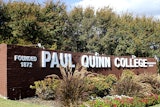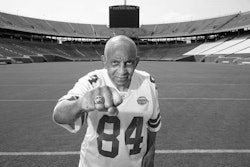AUSTIN, Texas — Two years ago, as a redshirt freshman, Ohio State University quarterback Cardale Jones came under fire for tweeting, “Classes are pointless.”
“Why should we have to go to class if we came here to play FOOTBALL, we ain’t come to play SCHOOL. Classes are pointless,” he’d said at the time.
Now, as the third-string quarterback prepares to start in the first college football national championship game, and in the wake of a growing number of academic scandals involving high-profile collegiate teams across the country, the validity of Jones’ assertion is again being debated.
Dr. Joseph Cooper, an assistant professor in the sport management program at the University of Connecticut, said universities have an economic imperative to bring Black student-athletes to campus that dates back to slavery and an economic system built on Black labor.
More bluntly, said Dr. Richard M. Southall, an associate professor in the University of South Carolina’s Department of Sport and Entertainment Management, “we do not want to admit as a society that we are exploiting the athletic ability of predominately African-American male athletes” to propel the education of the predominately non-African-American population on the broader campus.
Speaking Wednesday at the inaugural Black Student Athlete Conference, sponsored by The University of Texas at Austin’s African American Male Research Initiative, Southall and Cooper, along with several others, explored the idea of whether Black student-athletes really were brought to campuses to receive an education or if, as Jones asserted a few years ago, their primary purpose was to generate revenue for the institution.
Dr. Lisa Rubin, an assistant professor of student services in intercollegiate athletics at Kansas State University, agreed.
“Black athletic achievement is the marketing tool for PWIs,” or predominately White institutions, she said.
Rubin also revealed that “one-third of student-athletes at the 10 major state institutions that — I can guarantee you — have the resources to make sure they succeed are not graduating.”
But what about the recent NCAA report that student-athletes at Division I schools are graduating at “record rates” — 84 percent in an October report, compared with 65 percent of students overall at Division I schools?
Southall said the graduation rate data is a smoke and mirrors trick. The graduation success rate — the NCAA’s new metric for calculating graduation rates of student-athletes — said Southall is very misleading. It subtracts from the total student-athlete population any athletes who left in good academic standing (which were previously known as “eligible dropouts.”) By removing a large set of the population who dropped out, but were not flunking out, it falsely elevates the percentage of those graduating.
“If athletes are being successful academically, that is the quid pro quo,” he said. If schools “can release record graduation rates every year … we can tout a world-class education.”
But the truth is, Black profit athletes — those who play men’s basketball and football, the big revenue-generators for schools — drop out at rates significantly lower than other athletes, he said. And, what’s worse, “the better the team is, the lower the graduation rates and the greater the gap between student-athletes and the general full-time male student population,” said Southall.
This is because the most successful athletics programs are usually housed at the flagship research-intensive universities, he explained. So a majority of the students who enter full time were competitively admitted and already accustomed to a high level of academic rigor, thus better positioning them for academic success (and graduation) on campus.
Rubin and Southall are skeptical that the new NCAA academic standards will positively affect the trend of Black athletes not graduating at rates comparable to their counterparts on campus, be they other Black non-athletes or White students regardless of athletic participation.
“We can increase the standards, but are we really going to focus on academics?” Rubin asked.
Southall says no. The NCAA, as a whole, and individual schools, will continue to manipulate data so that there is an incremental increase each year and it appears new record graduation rates are being set every time a new report is released, he said.
One well-known problem is that athletics departments steer students into majors that are less rigorous to keep them eligible.
“Academic clustering is prevalent at every institution in Division I,” said Nino Rodriguez, a doctoral student at the University of Illinois at Urbana-Champaign. “Although it may lead to higher levels of academic eligibility, it steers [athletes] away from majors” that reflect their skillsets and interests, he said.
Not only that, Cooper said athletes are being isolated from the rest of the campus community, steered away from academic advisers and those who would help direct them into majors that reflect their interest. Self-contained athletics departments, with academic support teams and their own advisement structures, perpetuate the cycle of steering athletes into “easy” majors to help keep them eligible and continue to bolster the graduation rate data, should the athlete choose not to return to complete the degree.
“I think we’ve lost sight of the fact that knowledge and education are qualitative enterprises,” Southall said. Instead, universities focus on a numbers game perpetuated by the NCAA’s public relations teams. Whatever the number is that we need to meet … we’ll meet it,” he said.















